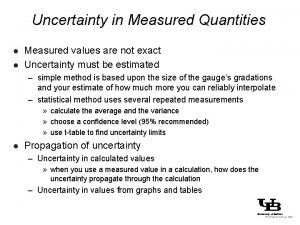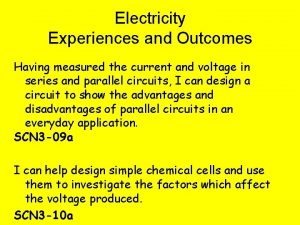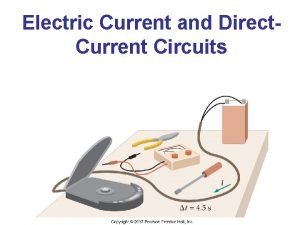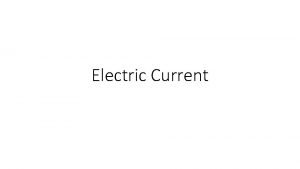Q How is current measured Current is measured












- Slides: 12

Q: How is current measured? • Current is measured in terms of the rate at which electrons travel THRU a circuit • In an equation, current is symbolized by I • Units: amperes or amps (A).

Q: How is current measured? • Tool Used to Measure: Ammeter • Comparison to water hose: – This is like if you sat in one spot and counted how many water molecules passed you in a certain amount of time – For example, if 20 water molecules (electrons) pass in 10 s, my current is 2 A. (20/10 = 2)

Q: What is voltage? • Voltage is a measure of the amount of force (pressure) that keeps the electrons flowing ACROSS circuit. – Imagine when you are walking in the hallway and people in front of you stop and block the hall. This creates a high pressure (pile of people/electrons) before the “resistor” (stopped people) and low pressure after. Causes VOLTAGE

Q: What is voltage? • In an equation, voltage has the symbol V • Units: Volts (V). – The voltage of a typical small battery is 1. 5 V. The voltage of a typical car battery is 12 V. • Tool Used to Measure: Voltmeter • Comparison to water hose: – This is like the water pressure difference before and after a blockage

Q: What is resistance? • The amount of resistance present tells us how much the flow (current) is restricted by the material (resistor) – Resistance is caused by friction. Different materials experience different amounts of friction.

Q: What is resistance? • In an equation, resistance is symbolized by r or R. • Units: Ohms (Ω) • Comparison to water hose: – This is like squeezing the hose in one spot (acting like a resistor) to cause the flow of water to slow down (resistance)

Q: How are all of these related? • Ohms Law: The current thru a circuit (I) is directly related to the force keeping the electrons flowing (V) and inversely related to the resistance (R) present in the circuit • Equation I= V R V I R

Q: How are all of these related? Units: I in amps, V in volts, R in ohms. DO NOT calculate before you convert to get rid of any prefixes (ie. m. V needs to be converted to V! kΩ needs to be converted to Ω!) Remember when we used to convert from kg to g? Or mm to m? Same idea here!

1)The headlights of a typical car are powered by a 12 V battery. What is the resistance of the headlights if they draw 3000 m. A of current when they are turned on? R = V/ I = 12 V/3 A R=4Ω

2) A clothes dryer is equipped with an electric heater. The heater works by passing air across an electric wire that is hot because of the current in it. The wire’s resistance is 0. 01 kΩ and the current in the wire equals 2400 c. A. What is the voltage across the heater wire? V = I x R = 24 A x 10. 0 Ω = 240 V

3)An electric car is equipped with a 50 hp (horse power) motor. The voltage across the motor’s terminals equals 500 V and the resistance in the motor’s circuit 7. 5 Ω. How large is the current in the motor? I = V/R = 500 V/ 7. 5 Ω = 66. 67 A

Agenda • Homework – Part 3
 Current is measured in
Current is measured in Non planar circuit
Non planar circuit Drift current and diffusion current
Drift current and diffusion current Drift current density unit
Drift current density unit Semiconductor
Semiconductor The constant-current region of a fet lies between
The constant-current region of a fet lies between Why must the electrode holder be correctly sized?
Why must the electrode holder be correctly sized? Line current and phase current
Line current and phase current Balanced wye delta connection
Balanced wye delta connection A balanced delta connected load having an impedance 20-j15
A balanced delta connected load having an impedance 20-j15 Hazard based safety engineering
Hazard based safety engineering Drift current density unit
Drift current density unit Slideplayer
Slideplayer






















